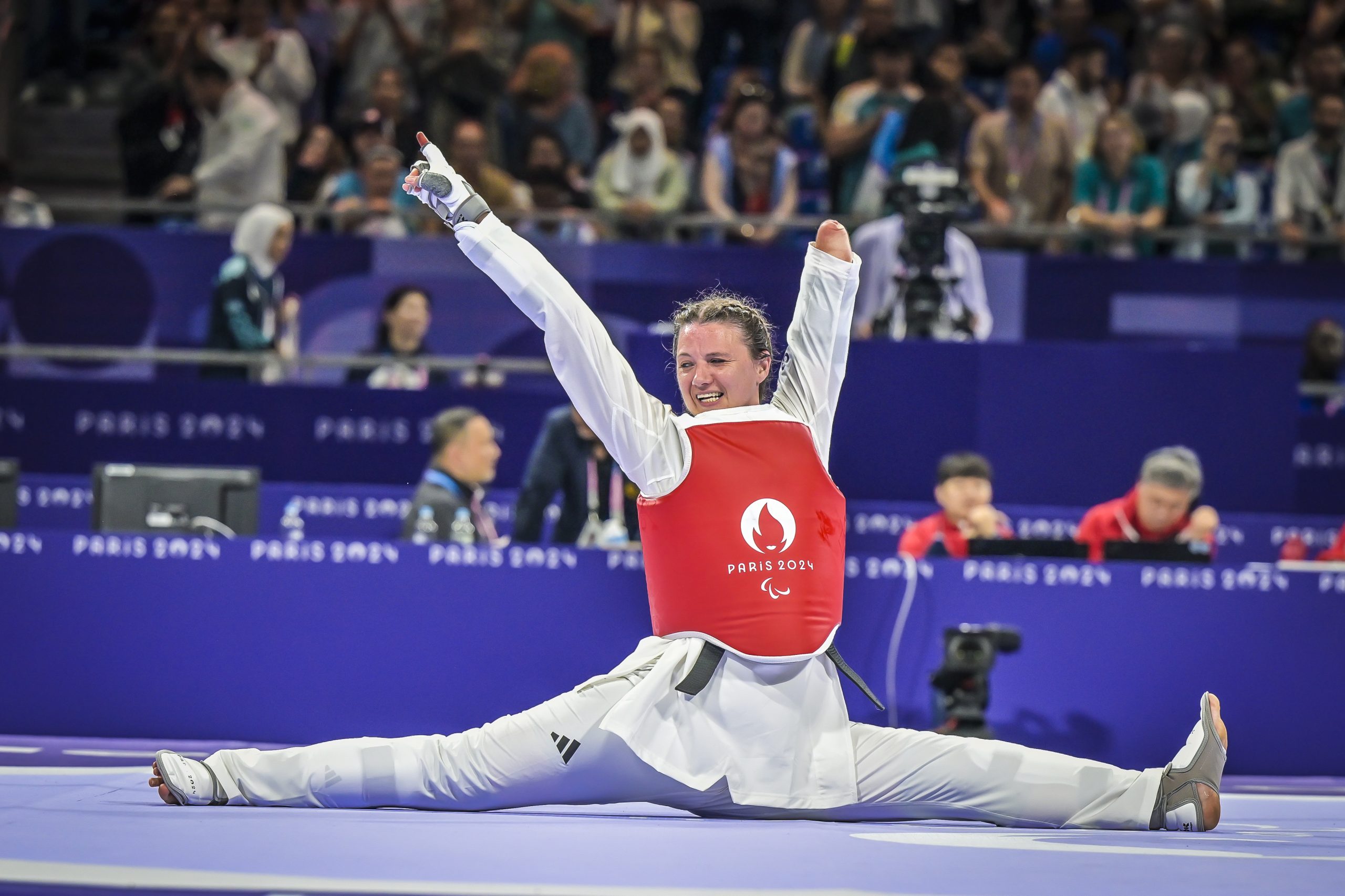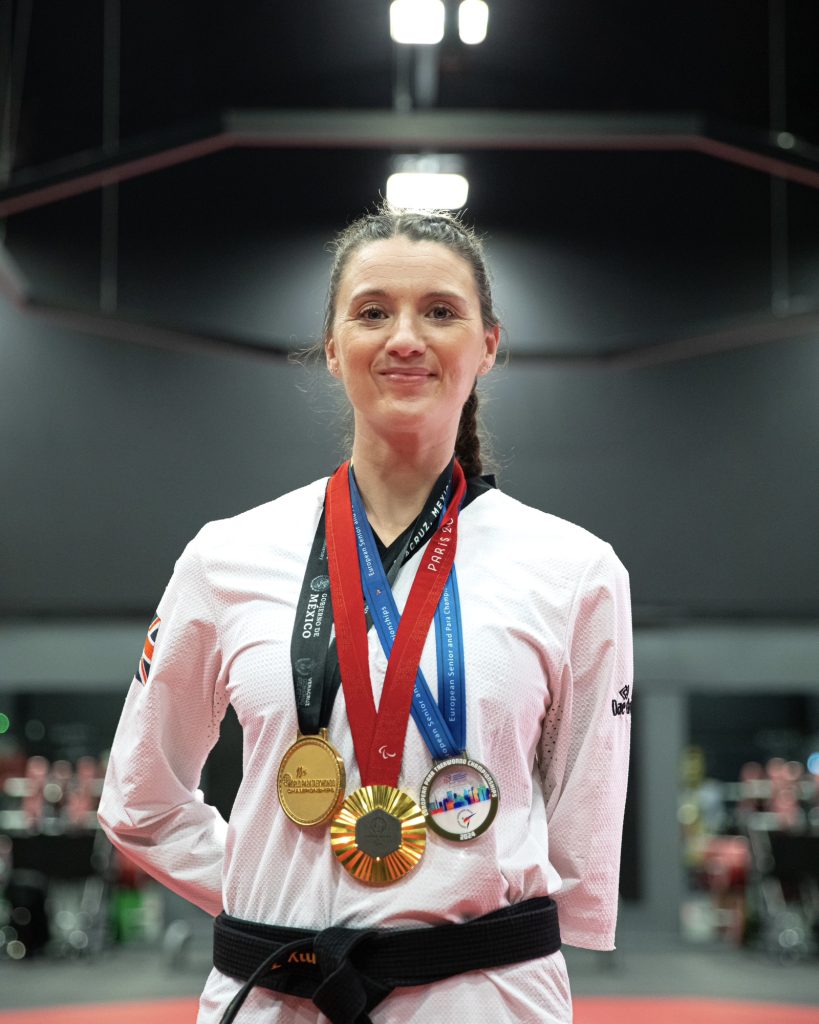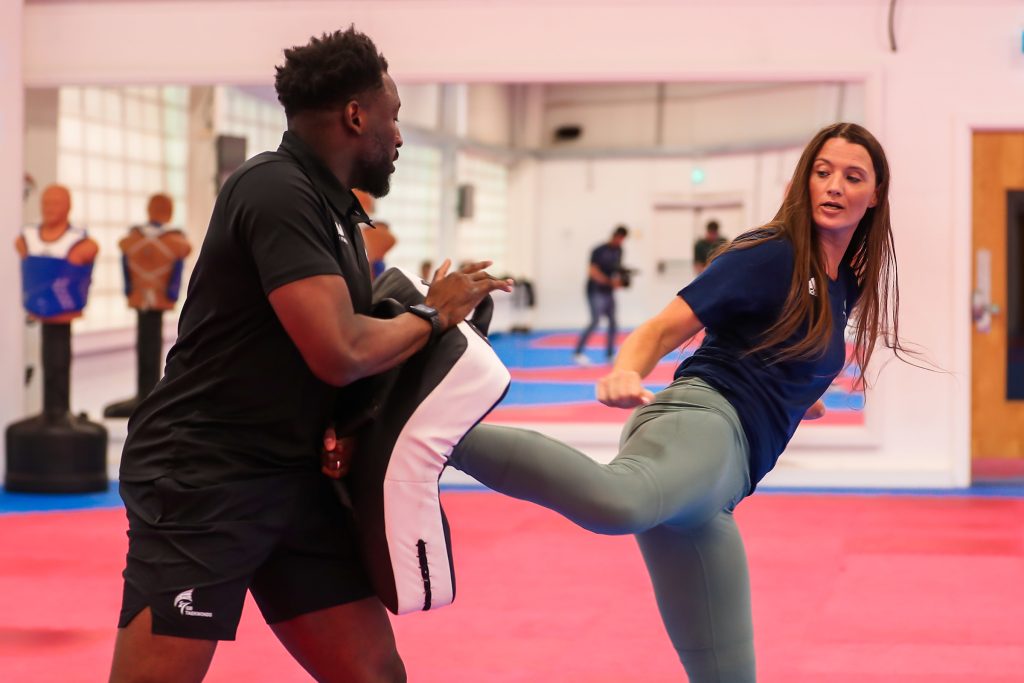What it takes to train, compete and win as a Paralympic athlete. An interview with Amy Truesdale…

Amy, what does a typical morning look like for you?
My day usually starts when I wake up around 7am, as my first training session of the day starts at 9:10am. Between 9:10am-9:30am we start activation, which is essentially waking up the muscles and preparing them before a training session. Exercises such as running, jumping and changing direction primes the nervous system resulting in being better prepared for performance.
I then train from 9:30 until 11:30am, which is usually a kicking session, but this generally depends on what themes we’re working on. For example, if it is a technical session, we would do high repetitions of specific taekwondo kicks, focusing on the hip and body position in order to practise the correct kicking technique which will increase our chances of scoring in a competitive situation.
After this session I have a break/lunch before my afternoon session which usually starts at 2:30pm and lasts around 90 minutes. The afternoon session is strength and conditioning consisting of either a weights/strength session or it could be a conditioning, performed on a bike, or a kicking conditioning session.
I try and focus on everything that is within my control and not what I can’t control.
A recent Instagram reel of yours showed an example of a training day which included activation and mobility, kicking, sparring rounds then recovery and stretching, a sports massage, followed by a steady aerobic bike session then strength training! That is a VERY physical day! How many days a week would you do that much training?
A typical training week for me consists of training twice a day, Monday to Friday, which is usually be a mixture of kicking sessions in the morning followed by strength and conditioning sessions in the afternoon.
Taekwondo sessions are usually in the mornings and last around 2 hours. Depending on what area we’re focusing on determines the content of the kicking session. If we’re closer to a competition the contact is higher, and we may practise more sparring-based scenarios which are high volume and contact.
The afternoon sessions are strength-based, which is weights or conditioning on the bike.
Our sessions are planned according to what phase of training we’re in and how close to competition we are, and this load is managed by our coaches and support staff.

How do you counter the physical days? What does a rest/recovery day ‘look’ like?
A rest day for me is chilling with my family and maximising my recovery using my recovery compression boots. If you haven’t tried them before, they are designed to target deeper muscles and aid faster recovery – they’re like placing your lower leg inside a balloon and inflating it around them.
How do you manage balancing training, recovery and personal life – staying social, seeing family and friends?
As our recovery days usually fall on the weekends, I spend this time catching up with my sister and my nephew. We often get our training plans for the week so you can plan anything you would like to do in the afternoon/evening. I often listen to various podcasts about mindset and mental resilience – I’ve also enjoyed being a guest on various podcasts as well!
One of the podcasts… The Vergeria Life Podcast: https://open.spotify.com/episode/2MmqKvUGywtKJaPxZvbjT5?si=5c522c6a9afc4010
How does your daily routine vary on competition days versus regular training days?
It’s quite different. First of all, on the day before a competition there’s a weigh-in and the event ‘draws’ are made, listing the opponent you will fight from the qualification matches towards the final. The match number tells you the order, and approximately what time, you need to be at competition area.
Competition days are a lot longer than a training day because there are lots of athletes competing in different weight divisions in the same ring (sometimes referred to as a court).
On the day of a competition a random list of weigh-ins will be released at 6am and this includes all the athletes who are selected for a check-up weigh-in to ensure they are within 5% of their original weight category.
As I am considered a heavyweight fighter, fighting in a plus 65 kg category, this does not apply to me. However, I still need to ensure I’ve fuelled correctly the night before in preparation for the long day of competing. I usually fight at around 67 kg which is an optimal fighting weight for me as I am still powerful and can move efficiently.
You will know your fight number and what ring you will be fighting in based on the draw sheets. However, the very first match starts the event around 9am.
Until Paris, the matches were a single 5-minute round, however the new rules have seen this change to 3 rounds of 2 minutes, with a 1 ½ min rest between rounds.
Depending on how many people are in your weight category you might be fighting every 2 – 3 hours and have up to 4 matches.
When you’re not fighting you are refuelling and warming up ready for your next match.
After the competition there’s a medal ceremony – this might be at around 8pm and then it’s likely you will be selected for ‘anti-doping’ testing and will need to provide a sample to ensure you are competing as a clean athlete – during competition it’s typically a urine sample which can be a lengthy process! After competing in Paris, I left the arena around 1am!

How do you keep your mental health game in check? What helps you to focus?
I try and focus on everything that is within my control and not what I can’t control. As a team we have done work using the chimp paradox framework which is basically understanding different parts of the brain and how they operate and how they respond in stressful situations. Having a better understanding of this framework has helped my mental health.
Read the Chimp Paradox by Professor Steve Peters: https://www.amazon.co.uk/Chimp-Paradox-Management-Programme-Confidence/dp/009193558X
What motivates you to keep pushing on the difficult training days?
The thing that motivates me to keep pushing is knowing that I’m inspiring other people to achieve anything they want.
Do you do anything specific to get psyched up on big days, like say, competing at the Paralympics!?
As a training group we have all adopted the phrase, “FIGHTING” which we often shout quite loudly around the gym!! Not only do we say this at the end of a sentence it’s also an encouraging buzzword to motivate individuals in sessions and it gets me in a good head-space to train.
You must have built up a great support system around you (coaches, teammates, family, etc.) – How important is such a network for a Paralympic athlete maintaining an intense training routine?
I have been fortunate enough to have access to psychological support at GB Taekwondo which enables me to be in a good mindset in preparation for competitions.
Using various coping mechanisms, including the chimp framework, has been a key support system for me and is something that I use regularly.
My support network is very small, but for me, my sister and my nephew are at the heart of it, and so it was amazing to have them both in Paris cheering for me!

In terms of awareness of your sport and being a Paralympian, what would you like people to understand more about the life of a Paralympic athlete?
I would like others to understand what a day in the life of a Paralympic athlete entails. I would also like people to be educated more about the capabilities of Paralympic athletes.
We are probably way more capable than you think, we train equally as hard and we are incredibly adaptable.
How does it feel to be recognised with an MBE (Member of the Order of the British Empire)? What does it mean to you in relation to your contributions to your sport?
I am delighted to be recognised with an MBE. It has been a goal of mine for many years and my teammates would often joke with me and say “Amy Truesdale MBE to be.”
It has been a deeply humbling and proud moment, and I am so pleased my dedication and commitment to a sport I fell in love with 28 years ago has been recognised.
Shared from Within Reach Magazine Spring 2025. Read the latest Within Reach magazine here!

